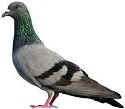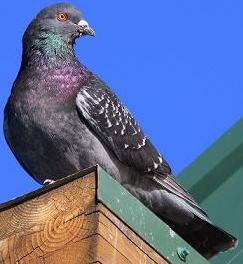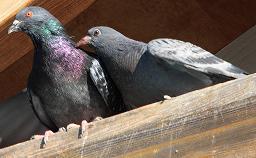Rock Dove - Domestic Pigeon  
Identification and Pictures
(Columba livia)
 Rock
pigeons, also called Rock doves, Blue Rock doves, feral pigeons,
and domestic pigeons, were officially name Rock pigeons
by the American and British Ornithologists Unions in
2004. They are about 13 inches, a little larger
than Morning Doves.
They are stocky birds, with short legs, short necks,
small round, bluish gray heads, slender bills, and a fleshy cere
just above the bill. The eyes are usually red or orange. Rock
pigeons, also called Rock doves, Blue Rock doves, feral pigeons,
and domestic pigeons, were officially name Rock pigeons
by the American and British Ornithologists Unions in
2004. They are about 13 inches, a little larger
than Morning Doves.
They are stocky birds, with short legs, short necks,
small round, bluish gray heads, slender bills, and a fleshy cere
just above the bill. The eyes are usually red or orange.
Photos by Keith Lee.
The camera I use is the Canon
EOS 40D.
Typically they
are gray with a white rump patch, two black bars on the
wings, a large black band on the tail, and red
feet. The feathers on the neck are often
iridescent blue or green. There are many domestic
color variations, with white, tan, black, and gray
colors. Females look much like the males but have
less iridescence around the neck. Young birds,
called squabs are duller. When pigeons walk they
bob their heads.
The names Pigeon and Dove are used interchangeably,
however ornithologists, normally considered pigeons
to be the larger bird. Pigeons have tapered wings
with powerful wing muscles, making them very strong, agile
fliers which can reach speeds of 85 miles an hour.
Carrier pigeons
Pigeons have been domesticated for
thousands of years. Although sometimes they were
just pets, because of their ability to find home when
released they have been used as carrier, and homing
pigeons, carrying messages during war time. During
World Wars 1 and 2 their use in carrying messages across
enemy lines saved thousands of human lives. It is
thought by some that their navigation abilities are a
result of being able to sense the earth's magnetic fields
with magnetic tissues in their heads.
Birmingham Rollers
Birmingham roller pigeons are an
incredible sight to see. The birds have a talent
for doing backward somersaults as they spin towards the
earth. Hobbyists train the birds and their are
world wide completions to see who can their flock of
birds to perform the best. View
roller pigeon video.
There are 12 recognized subspecies of
Rock pigeons.
Range and Habitat
 Rock
pigeons range year round, from southern Canada, across the U.S.,
and South America. They thrive in populated areas,
and flocks of pigeons may be found in large cities, and
rural areas around the world. They can be seen in
crowded streets, and public places, often roosting
together on buildings, cliffs, and
bridges. Rock
pigeons range year round, from southern Canada, across the U.S.,
and South America. They thrive in populated areas,
and flocks of pigeons may be found in large cities, and
rural areas around the world. They can be seen in
crowded streets, and public places, often roosting
together on buildings, cliffs, and
bridges.
Breeding and Nesting
In courtship the male will strut around
the female with his chest puffed out, and his tail
spread, while bowing, and cooing. Although spring, and summer are their
main breeding periods, pigeons may breed at any time
during the year, and could have 5 or more broods.
They are usually monogamous. Pigeons and doves build
crude nests of sticks, and
straw, on window ledges, cliffs, under bridges, in
trees, or on the ground. The male will bring
nesting material to the female, and she builds the
nest. The female
will normally lay two white eggs. Both birds will
incubate the eggs for 17 to 19 days. The pair will
take care of the young birds, which may be in the nest
for as long as a month. Both sexes produce nutritious
crop milk they feed to the young.
Song and Call
They make a soft gurgling sound, like
coo-roo-coo.
Food and Feeding
Pigeons eat seeds, grains, berries, and
scraps from people. They like to feed on the ground in
open areas. They are very comfortable around
people, and will often approach them for food.
Unlike many birds, pigeons
can dip their bills into the water, and drink without having to tilt their heads back.
They can be attracted to backyards with seeds, cracked
corn, popcorn, bread, and other food scraps.
Because they are often in large flocks many people
discourage them by using anti-roosting pigeon spikes.
For more
on food and feeding click here.
For more on feeders click here.
To learn about other
favorite birds click here.

|
|
|
 All-birds Store
All-birds Store
Bird Watching guides, books, binoculars,
cameras, gifts for bird lovers, bird baths, feeders
and more... baths, feeders
and more...
|
|
|
